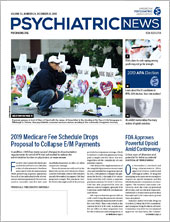The opioid receptor antagonist naltrexone is a proven treatment for opioid use disorder (OUD), but the clinical usefulness of oral naltrexone has been limited by poor adherence. A study published October 19 in AJP in Advance now suggests that patients with OUD may be twice as likely to stay in therapy if they receive monthly injections of extended-release naltrexone (XR-naltrexone) following opioid withdrawal compared with daily oral naltrexone.
“These study findings have immediate clinical relevance for treatment of opioid use disorder at a time when an opioid epidemic continues unabated in the United States,” wrote Maria Sullivan, M.D., Ph.D., of Columbia University and colleagues. “Given that post-detoxification outpatient treatment without pharmacotherapy yields poor completion rates, high (60 percent to 90 percent) relapse rates, and heightened risk of overdose and death, XR-naltrexone may be a viable alternative to prevent relapse in patients seeking treatment for opioid use disorder who do not prefer an agonist approach [such as methadone or buprenorphine].”
Sullivan and colleagues randomized 60 adults aged 18 to 60 who met DSM-IV criteria for opioid dependence to receive either 50 mg/day oral naltrexone (32 patients) or 380 mg of monthly XR-naltrexone (28 patients) for 24 weeks. All the participants received one 50 mg naltrexone pill at the start of the study to make sure they could tolerate naltrexone.
The study participants were asked to visit the clinic three times a week for the first two weeks and then twice weekly for the remainder of the 24-week study. During each clinic visit, the patients took a urine test, discussed any recent substance use, and took part in a behavioral therapy session. The goal of the behavioral therapy, which included both individual and family sessions, was to educate, motivate, and support patients through the process of opioid detoxification, naltrexone induction, and successful naltrexone maintenance. To encourage attendance at clinic appointments, patients were entered in a drawing for the chance to win gift vouchers after each session they attended.
After four weeks, four of the 28 (14.3 percent) patients receiving XR-naltrexone had dropped out of treatment, compared with 12 of 32 (37.5 percent) patients receiving oral naltrexone. By the end of the 24-week study, 12 of the 28 (43 percent) patients receiving XR-naltrexone had dropped out of treatment, compared with 23 of 32 (72 percent) patients receiving oral naltrexone.
“[T]his trial shows that even in the presence of an intensive behavioral regimen aimed at supporting medication adherence, oral naltrexone is an inferior treatment and should be avoided clinically, other than perhaps for very select cases with a high likelihood of adherence,” Sullivan and colleagues wrote.
There were no significant differences in side effects between the two groups, other than a higher rate of insomnia among patients taking oral naltrexone. There were nine serious adverse events, but only one was found to be related to medication: one patient receiving XR-naltrexone developed allergic hives and was removed from the study.
“Ever since extended-release naltrexone was approved for opioid use disorder back in 2010, experts in the field have been saying it should be the formulation of choice when treating patients with naltrexone,” said Andrew Saxon, M.D., a professor of psychiatry and behavioral sciences at the University of Washington and director of the Center of Excellence in Substance Abuse Treatment and Education at the VA Puget Sound Health Care System. “These findings now provide experimental data to back up this consensus.” Saxon, who is also the chair of the APA Council on Addiction Psychiatry, was not involved in the study.
Because prize drawings to encourage attendance would be hard to implement at many community drug centers, Saxon said that the treatment retention rates seen in this study may not be as high in a real-world setting.
Initiating naltrexone use following opioid withdrawal remains a significant challenge, Saxon told Psychiatric News; induction requires about seven to 10 days of opioid detoxification to make sure all opioids have left the patient’s system. In this study, 110 patients enrolled in the opioid withdrawal program, but only 60 were able to complete it and transition onto naltrexone therapy.
This study was supported by grants from the National Institute on Drug Abuse. ■
“A Randomized Trial Comparing Extended-Release Injectable Suspension and Oral Naltrexone, Both Combined With Behavioral Therapy, for the Treatment of Opioid Use Disorder” can be accessed
here.
